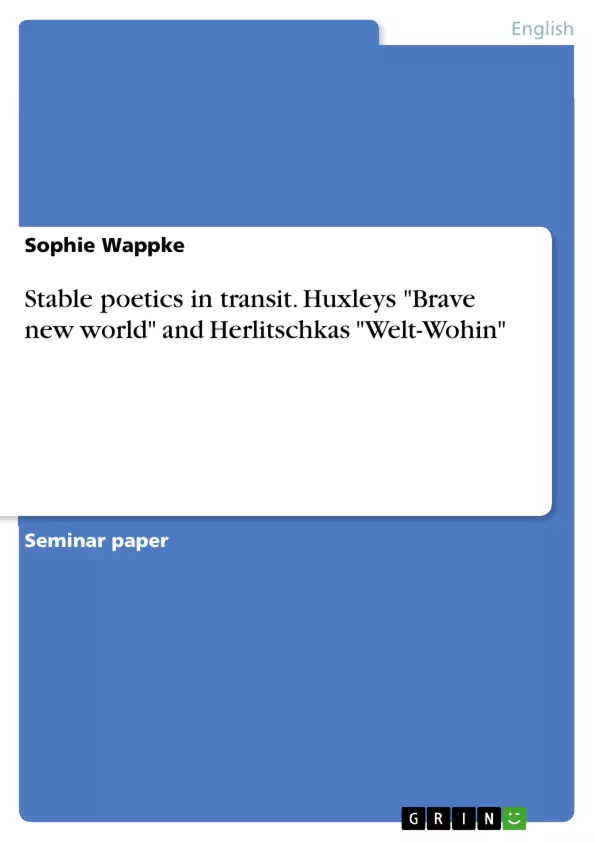In the first chapter the work of translation as a form of literary art will be explained. Especially the works of Greiner and Gadamer were of great help in outlining the vast but young field of literary translation. The chapter focuses on the development of literary translations as a field of study and on the translator’s role as a mediator between cultures.
The second chapter focuses on the genre of utopianism. In order to analyze Herlitschka’s translation, this aspect of methodological knowledge is crucial. A short abstract of the genre’s development will be given. Also, the etymological definition of utopia will be explored. Furthermore, the words dystopia and anti-utopia will be defined. After these rather technical definitions, utopia, dystopia and anti-utopia will be defined as literary concepts. How are they different? And which concept does BNW identify with? The concepts of alienation and the importance of the reader will thus be touched upon, too.
Helpful throughout the whole chapter was especially the Cambridge Companion to Utopian literature.
After having laid out the theoretical and methodological foundation of this paper, the third chapter commences with the analysis of Herlitschka’s translation. In a first step, the narrative structure will be focused on.
Also, Herlitschka’s poetics will be studied in depth in order to present in detail whether his translation is a piece of own literary art or not. Following this thought it is important to see how he dealt with crucial passages. How did he alter the syntax? How is the English “you” translated to the German “du” or “Sie”?
Speaking of alteration, the characters and their renaming will be covered in a next step. Does Herlitschka change the notions characters imply in BNW? If so how does he utter this linguistically? Why are many names and all places changed?
Specifics that seem typical in Herlitschka’s translation will be slightly touched upon. Not all specifics will be named but the most striking ones will be explained. Interesting is to see how he deals with vocabulary repetition and different semantic notions words have when being transferred to another language.
Inhaltsverzeichnis (Table of Contents)
- Introduction
- The art of literary translation
- Utopian Fiction
- an attempt to define a genre
- The etymological meaning of utopia, dystopia and anti-utopia
- Utopia, dystopia and anti-utopia as literary concepts
- Herlitschka's translation from 1932
- Narrative structure
- Characters
- Specifics of Herlitschka's translation
- Conclusion
Zielsetzung und Themenschwerpunkte (Objectives and Key Themes)
This paper aims to analyze the translation of Aldous Huxley's *Brave New World* (further reference BNW) by Herbert Egon Herlitschka, titled *Welt-Wohin*. The focus lies on understanding the translation as a distinct literary work and exploring the impact of translation choices on the original text. The paper aims to contribute to the understanding of literary translation as a form of artistic creation.
- The art of literary translation as a form of mediation between cultures
- The genre of utopian fiction and its literary concepts
- The specificities of Herlitschka's translation of *Brave New World*
- The role of the translator in shaping the reader's experience
- The interplay between the original text and its translation
Zusammenfassung der Kapitel (Chapter Summaries)
The first chapter introduces the concept of literary translation, emphasizing its artistic nature and the translator's role as a mediator between cultures. It explores the development of literary translation as a field of study and examines the works of key figures like Greiner and Gadamer.
Chapter two delves into the genre of utopian fiction, focusing on the etymological meaning of utopia, dystopia, and anti-utopia. It analyzes the development of the genre and defines these terms as literary concepts. This chapter also touches upon the concepts of alienation and the importance of the reader's experience.
Chapter three commences the analysis of Herlitschka's translation of *Brave New World*, focusing on the narrative structure, character portrayals, and specific translational choices made by Herlitschka. It examines how Herlitschka's translation choices impact the reader's understanding of the original text.
Schlüsselwörter (Keywords)
This paper delves into the realms of literary translation, utopian fiction, and comparative analysis. It explores the key concepts of mediation, cultural exchange, artistic translation, and the impact of translation choices on the original text.
- Quote paper
- Sophie Wappke (Author), 2015, Stable poetics in transit. Huxleys "Brave new world" and Herlitschkas "Welt-Wohin", Munich, GRIN Verlag, https://www.grin.com/document/337113



